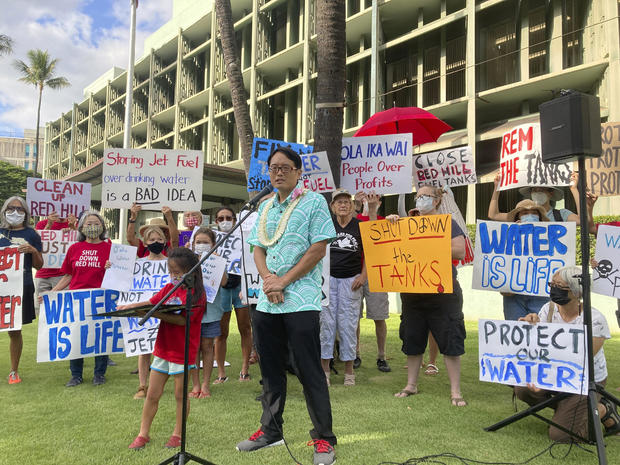Hawaii health department issues emergency order after petroleum products found in Navy water system
The Hawaii Department of Health issued an emergency order on Tuesday, calling on the Navy to take further action to remedy its water system after tests detected petroleum products in one of its wells. The order comes a day after Navy officials at Joint Base Pearl Harbor-Hickam announced they would suspend operations at a major fuel tank farm located near the contaminated water well.
"The Navy's contamination of drinking water has impacted all O'ahu residents—military and civilian—and we must take appropriate steps to safeguard the drinking water we all share as a community," Hawaii's health director Dr. Elizabeth Char said in a statement Tuesday.
Along with the immediate suspension of operations at Red Hill Bulk Fuel Storage Facility — which is located 100 feet above an aquifer that supplies water for the Navy's water system — the emergency order calls on the Navy to take immediate steps to install water treatment systems at the site's shaft. The state's health department also ordered the Navy to submit a work plan as well as an implementation schedule to safely remove the fuel from Red Hill's storage tanks and assess its operations within 30 days.
On November 28, the Navy shut off its water system following complaints from nearby residents that their water smelled like fuel. Several days later, testing showed a water sample from the Red Hill well, which originates at the Moanalua-Waimalu aquifer, contained petroleum hydrocarbons and hydrocarbon vapors. The EPA describes petroleum hydrocarbons as "a large family of several hundred chemical compounds that are derived from crude oil."
It is not clear exactly what kind of petroleum products were detected or how they got into the system. However, the fuel storage facility has had several fuel leaks over the years, including one in November, but the Navy insisted there were "no signs or indication of any releases to the environment."
According to the the Centers for Disease Control and Prevention, exposure to different total petroleum hydrocarbons can cause fatigue, headache, nausea, drowsiness, paralysis and death depending on the length of the exposure and type of chemical compound.
The Hawaii Department of Health recommends those who use the Navy's water system — which includes 93,000 residents living in and near Pearl Harbor, according to the Associated Press — avoid using it for drinking, cooking or oral hygiene and to avoid bathing and washing dishes and laundry if water smells like fuel.
After the tests came back positive for petroleum hydrocarbons last week, the Navy vowed to flush clean water through its distribution system to clear contaminants from the water. Commanding Officer of the Naval Facilities Engineering Systems Captain James Meyer said the Navy is currently drafting a schedule to provide residents a timeline of when they can resume using water in their homes. The Navy is also handing out bottled water and helping eligible residents impacted by the water crisis find other accommodations.
Meanwhile, residents say the contaminated water has contributed to an array of health problems.
A nursing mother said she and her husband have had "mysterious symptoms such as sore throats, burning in my stomach, profuse, unusual sweating, headaches unable to be mitigated, requiring multiple ER visits for additional medications, vomiting, diarrhea, skin irritation." She said her family also recently put down their dog after the animal experienced an array of "mysterious symptoms."
"I'm here to ask why you weren't a wingman to protect my 13-month-old son when I was bathing him, when I was giving him a sippy cup full of water from my faucet, when he has been throwing up for days on end," the woman, who did not identify herself, asked Sunday at a town hall meeting with Navy officials.
Another man said that his wife has reported "debilitating" symptoms possibly related to the contaminated water like confusion and altered consciousness. "There could be some correlation," he said.
Joint Base Commander of Pearl Harbor-Hickam Captain Erik Spritzer said he is "deeply remorseful" for not telling families to avoid the contaminated water sooner and that the Navy believed it was safe to drink based on water tests.
"We were wrong," he wrote in a statement on Sunday. "I apologize with my whole heart that we trusted those initial tests."
The Red Hill Bulk Fuel Storage Facility has 20 steel-lined underground tanks, which can collectively store up to 250 million gallons of fuel. The tanks are encased in concrete and stored inside cavities of a volcanic mountain ridge near Honolulu, according to the Associated Press. Pipelines from the tanks run 2.5 miles inside a tunnel to fueling piers at Pearl Harbor.





